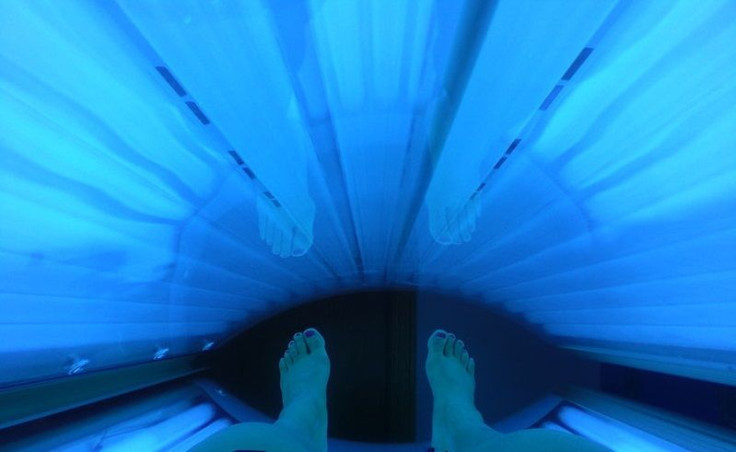Addicted To Indoor Tanning? Psychologically Dependent Tanners With Skin Cancer Continue To Tan

With the summer here, some people go to the beach, while others go to a tanning salon to appear as if they have, despite increasing their risk of skin cancer. Some of these tanners take the habit one step further by continuing to tan despite already having skin cancer, as a new study shows that one in seven people with skin cancer still go tanning after they're diagnosed.
Although researchers are stopping short of calling it an addiction, they say "tanning dependence" is similar to substance dependence, analogous to people who smoke even after being diagnosed with a tobacco-related cancer.
"What's always surprising, both in this study and in prior research, is that the people who have a diagnosis of skin cancer — the ones who should be the most vigilant because they have been educated about skin cancer — are the ones who are continuing to expose themselves to a known carcinogen," Dr. Richard Langley, the president of the Canadian Dermatology Association, told CTV News. Dr. Langley wasn't involved in this study.
How Addicted To Tanning Are They?
The study included 178 skin cancer patients from Connecticut. All of them had been to tanning salons before they were diagnosed, were white or non-Hispanic, had basal cell carcinoma — the most common form of skin cancer — and the majority of them were women.
Four years after their diagnosis, they filled out surveys that asked about their tanning activity since diagnosis, as well as questions that would indicate whether they had any symptoms of tanning dependence. The results showed that 26 participants reported going back to indoor tanning, with a median of 10 trips to a tanning salon in a year. Some even reported tanning as many as 20 times a year.
The participants who reported tanning the most before they were diagnosed were also the ones who were more likely to go tanning afterward. Of those who went back, 58 percent showed signs of tanning dependence.
Although basal cell carcinomas, which usually appear on sun-exposed parts of the skin in the form of waxy bumps or sores, can be removed, Langley cautions that anyone diagnosed with skin cancer is at a higher risk of getting it again, including the most deadly form, melanoma. He says people who continue to tan are in denial, a defense mechanism common for addicts.
"A patient with a cancer diagnosis from a known carcinogen who continues to expose themselves to that carcinogen is often in denial," Langley said. "That's a prominent sign of dependency."
He says many of them refuse to believe ultraviolet (UV) radiation can cause skin cancer, and that they're often in a "state of disbelief." Others will assert that cancer just runs in their family. Still, others tell him about the great feelings they get from tanning — likely caused by opioid-like endorphins released from UV exposure.
"Patients will often describe that it feels good when they get sun exposure or go to a tanning salon... They talk about needing to do it and craving it, and when they don't do it, a feeling of withdrawal," Langley said.
Trying To Kick A Tanning Addiction
A previous study, although small, showed that participants who were frequent tanners could experience withdrawal symptoms when the endorphins were blocked from activating. The researchers tested whether naltrexone, which blocks these endorphins, would cause withdrawal symptoms in eight frequent tanners and eight infrequent tanners, who served as control subjects. Four of the frequent tanners reported feelings of nausea and jitteriness after they were exposed to UV radiation, while the infrequent tanners reported nothing.
Another study found that the younger a teenager started tanning, the harder it was for them to quit. Out of 1,275 adolescents, ages 14-17, 21 percent reported difficulty trying to quit. Those who started as young as 13 years old showed the most difficulty.
"I think it's still under-recognized, in part because it hasn't been well documented in the medical literature," Langley said. "However, those of us in the [dermatology] field certainly have recognized it for some time."
Restricting Teens From Tanning
Because of its addictive, cancer causing qualities, public officials have taken measures to limit adolescents' usage of tanning beds. In New Jersey, Governor Chris Christie signed a bill in April banning the use of tanning beds for minors under 17 years old and requiring adolescents ages 17-18 to get parental consent. Teens 14-17 years old are allowed to spray tan, however, but would also need parental consent.
The Food and Drug Administration (FDA) also proposed new labeling on all tanning beds and lamps that would warn minors of the consequences of increased use.
"Using indoor tanning beds can damage your skin and increase your risk of developing skin cancer," FDA Commissioner Margaret A. Hamburg, said in a statement. "The FDA's proposed changes will help address some of the risks associated with sunlamp products and provide consumers with clear and consistent information."
Sources: Cartmel B, Ferrucci L, Spain P, et al. Indoor Tanning and Tanning Dependence in Young People After a Diagnosis of Basal Cell Carcinoma. JAMA Dermatology. 2013.
Kaur M, Liquori A, Lang W, Rapp SR, et al. Induction of withdrawal-like symptoms in a small randomized, controlled trial of opioid blockade in frequent tanners. Journal of the American Academy of Dermatology. 2006.
Zeller S, Lazovich D, Forster J, et al. Do adolescent indoor tanners exhibit dependency? Journal of the American Academy of Dermatology. 2006.
Published by Medicaldaily.com



























